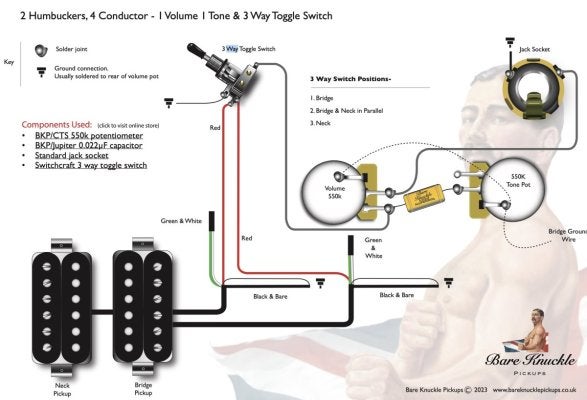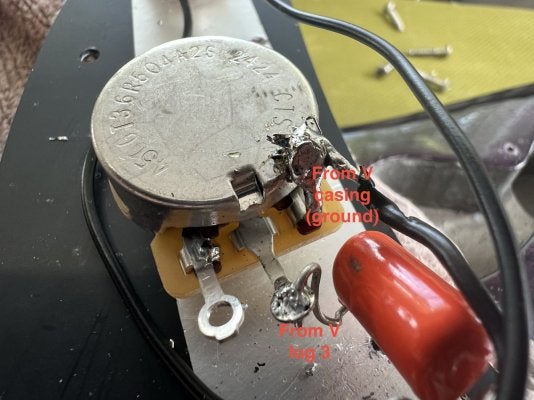cowardm
Tele-Holic
Hi all,
Given that this was my first attempt at soldering, it's just as likely that I fried something as it is that I wired it wrong. If it's any noise at all, it's quite, hisses, buzzes. Flipping the switch just makes the noise better or worse.
Here are the players:
Neck: Wilde (Bill Lawrence) L45 Strat
3 wires: white, black, blue
White = hot (source 1, source 2)
Blue/black = ground
Bridge: Seymour Duncan JB SH-4
Black = hot
Green/plain(gray) = ground
Red/white = unused
1 Vol pot 500k
1 tone pot 500k
1 3-way switch
1 mono output jack
I used this Seymour Duncan wiring diagram as the basis.
Here is the diagram I cooked up. For the pickups themselves, I used the colors of the actual wires. For everything else, I tried to use a few different patterns and colors to make it less confusing with the gray wires almost always representing going to ground. I'm a little surprised that the ground output of the 3-way switch doesn't go to the ground on the volume pot in the Seymour Duncan diagram, but I tried both ways and in either case it doesn't work.
The ground to the bridge is actually screwed into the control cavity, which has conductive shielding paint.

Given that this was my first attempt at soldering, it's just as likely that I fried something as it is that I wired it wrong. If it's any noise at all, it's quite, hisses, buzzes. Flipping the switch just makes the noise better or worse.
Here are the players:
Neck: Wilde (Bill Lawrence) L45 Strat
3 wires: white, black, blue
White = hot (source 1, source 2)
Blue/black = ground
Bridge: Seymour Duncan JB SH-4
Black = hot
Green/plain(gray) = ground
Red/white = unused
1 Vol pot 500k
1 tone pot 500k
1 3-way switch
1 mono output jack
I used this Seymour Duncan wiring diagram as the basis.
Here is the diagram I cooked up. For the pickups themselves, I used the colors of the actual wires. For everything else, I tried to use a few different patterns and colors to make it less confusing with the gray wires almost always representing going to ground. I'm a little surprised that the ground output of the 3-way switch doesn't go to the ground on the volume pot in the Seymour Duncan diagram, but I tried both ways and in either case it doesn't work.
The ground to the bridge is actually screwed into the control cavity, which has conductive shielding paint.





